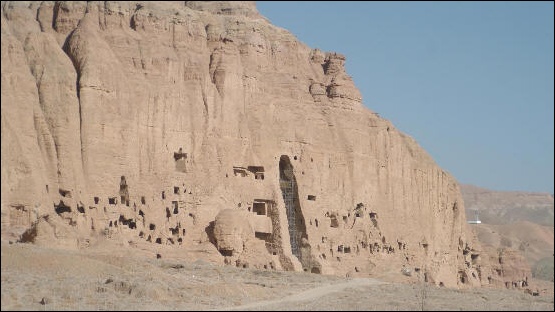Leaders Discuss Bamyan Development, Visit Ruins
Leaders Discuss Bamyan Development, Visit Historical Ruins
For more than 1,500 years they stood watch over the people of Afghanistan's Bamyan province. The Buddhas of Bamyan remained untouched, nestled in the heart of the Hindu Kush Mountains until they were destroyed by the Taliban in March 2001.

A series of caves remains where the Buddhas of Bamyan used to stand prior to their destruction in 2001 by the Taliban. The Buddhas of Bamyan were two monumental statues of standing Buddhas carved into the side of a cliff in the Bamyan valley of central Afghanistan. Photo by Senior Airman Dilia DeGrego, USAF
An Afghan National Army soldier stands guard at the ruins of the Buddhas of Bamyan. The Buddhas of Bamyan were two monumental statues of standing Buddhas carved into the side of a cliff in the Bamyan valley of central Afghanistan.
Since their destruction, the local government and people have sought to restore this cultural landmark. Although various countries have come forth with an interest in restoring them, their remnants wait, guarded at the foot of the mountain in which they once stood, and their future is a topic of discussion among the international and local community.
This topic, among others, was highlighted during a meeting between Bamyan government officials and coalition and International Security Assistance Force leaders Nov. 10.
German Maj. Gen. Bruno Kasdorf, NATO International Security Assistance Force chief of staff; U.S. Army Col. Jonathan Ives, Task Force Cincinnatus commander; New Zealand Col. Brendon Fraher, provincial reconstruction team contingent commander; and other coalition and ISAF leaders visited with the Bamyan deputy governor to discuss the province's overall progress, as well as the local government's development priorities for the area.
They were all pleased to find the people and government working hand in hand toward a brighter future for the region.
"In all six districts that we have in Bamyan, reconstruction is going on to the limit that (the governor) has in her power," Bamyan's deputy governor said. "There are also other sources that are helping her as well. We see the future of Bamyan very bright. We are not worried about the future of Bamyan because all of the people of Bamyan are united with their government.
"The governor, the leader of this area, is a very competent woman, and she is a very hard worker," he continued. "The men and women of this area are very happy with her."
Working with their government, he said, the people of Bamyan have turned the once war-torn area into a peaceful one, where there are no armed people walking around and agriculture, although in need of modernization, is doing well. In addition, there is no longer any poppy seed cultivation in the province.
"We hope the government will see and realize that in Bamyan is a very peaceful province, and that is why we need the government to have more attention to this area," the deputy governor said. "We want more reconstruction in this area."
Kasdorf agreed. "I am on your side," he said, "because it is a secure area, we should reinforce the success you've already had. This is a peaceful region, and if we should show everybody else that we have this kind of conditions here, we will have progress."
The leaders went on to discuss the needs of the people to continue with the successful development of the area. The deputy governor stressed some of the province's main priorities, including the need for professionally trained teachers, schools for their children, markets for their vendors and most importantly, roads to make it all possible.
"The schools cannot be built here without roads, and the teachers cannot come here to teach because we don't have roads," the deputy governor said.
The leaders also discussed boosting the economy, specifically the area's natural resources, like coal and iron ore, and what needs to be done to mine and market these -- again, stressing the need for roads to transport and properly market the resources.
The leaders concluded their meeting discussing the region's rich heritage -- the Bamyan Buddhas.
"We want people to come help repair these statues," an Afghan Ministry of Information and Culture representative said. "The people ask when they will be rebuilt. They are guarding and preserving the pieces of the Buddhas so in the future, if they are rebuilt, we can use some of the original pieces.
"We are doing what we can to preserve what is left of the historical paintings and writings, as well, putting up doors to the rooms that those paintings and writings are in," he said. "It is very important to preserve this historical area. Everyone wants to this area to be preserved. We want to rebuild it so the others can come and see the area and its historical value."
(Air Force Senior Airman Dilia DeGrego is assigned to Combined Joint Task Force 82 Public Affairs.)
ENDS
More: Latest World News | Top World News | World Digest | Archives


 Our Schools: Trump And Republicans Want Taxpayers To Fund Their Pet Project - Private Schools
Our Schools: Trump And Republicans Want Taxpayers To Fund Their Pet Project - Private Schools Science Media Centre: Dengue In The Pacific Region – Expert Q&A
Science Media Centre: Dengue In The Pacific Region – Expert Q&A New Zealand Defence Force: NZDF Prepares For Major Warfighting Exercise In Australia
New Zealand Defence Force: NZDF Prepares For Major Warfighting Exercise In Australia Greenpeace: Dairy Industry Greenwashing Under Fire As Lawsuits Go Global
Greenpeace: Dairy Industry Greenwashing Under Fire As Lawsuits Go Global Greenpeace: French Authorities Block Greenpeace Ship From Participating In UN Ocean Conference
Greenpeace: French Authorities Block Greenpeace Ship From Participating In UN Ocean Conference ITUC: Workers' Rights Collapse Across The World - ITUC Global Rights Index 2025
ITUC: Workers' Rights Collapse Across The World - ITUC Global Rights Index 2025